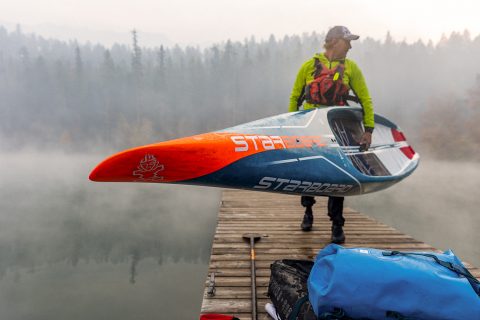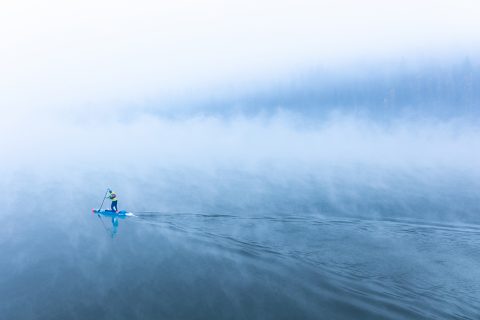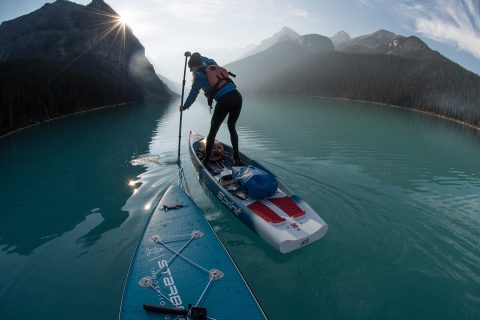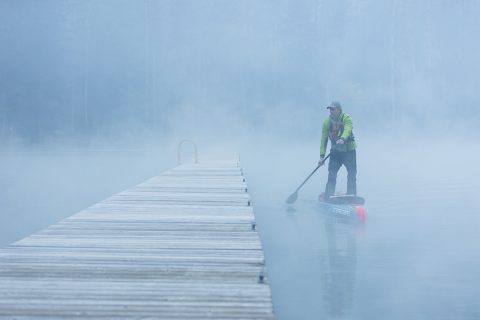MISSION ‘SPRINT EXPEDITION’
BRUCE KIRKBY
Bruce Kirkby tells us about his mission to design Starboard’s ‘Sprint Expedition’, the ultimate board for exploration.
Words: Bruce Kirkby // Photos: Nicole Leclair and Bruce Kirkby
BACKGROUND
I came to the world of SUP with an expedition background. For more than three decades I’d pursued long expedition in remote wildernesses around the world; riding camels across Arabia, guiding rafts in the Arctic and Africa, paddling sea kayaks in Greenland, Borneo and all over Canada’s West Coast.
It was the freedom of standing on water – as intoxicating and invigorating as surfing – which first drew me to the sport of SUP. After my first paddle, I immediately ordered an inflatable, and that same month, paddled 100km in a fundraiser for African drought relief.
Straight from the word go, I sensed the potential for exploring remote coastlines by paddleboard, but what stood out the most, was the potential for quick self rescue. If you capsize a sea kayak in rough seas, the situation can quickly become dire, but if you tumble off your board – which is a common occurrence – it’s really no big deal. Crawl back on, and seconds later, off you go again.
- Testing in the mist
TOOLS OF THE TRADE
Soon, I began planning a journey along the exposed outer shores of Vancouver Island, and scavenged the internet for an appropriate board. I wanted something capable of carrying heavy loads, which could navigate both swell and chop, yet still able to move efficiently through flatwater. However, after an exhaustive search, I concluded that nothing matched the bill. There simply wasn’t a serious expedition paddleboard on the market in those days.
With no other option, I ordered a 16×32 inflatable tandem paddleboard, glued a matrix of d-rings across the deck, and set off into the unknown. The 450 litre beast raft could easily manage my 100 pounds of kit I strapped to it, but she was a pig in crosswinds and sluggish on the flats. During those long paddling days, I often found myself pondering: If I could build the expedition SUP of my dreams, what would it look like? What would the critical design elements be? What efficiencies could be gained?
During the years which followed, I tackled increasingly longer and more challenging wilderness SUP journeys, and experimented with a variety of boards described by their manufacturer as ‘Touring’ models. Most offered relatively stable platforms, although none had nearly enough tie downs to secure a week’s worth of food and gear. The majority appeared to be designed to carry a day pack and water bottle, but nothing more. So, I continued to refine my ideas.
- Bruce Kirkby
THE CHALLENGE
Then, in 2018, Starboard invited me to join the Dream Team, and my top priority became combining my wilderness paddling experience with their depth of design knowledge to create the world’s very best Expedition SUP.
I suggested we begin with the legendary All Star. Years of meticulous refinements had already created a board of unrivalled pedigree – and proven reputation – not to mention several World Championships. What if we added a few inches of width, increased the nose thickness, and then excavated a larger dugout, capable of accommodating luggage fore and aft of the paddler? Of course, there would be many other critical details to address, but this seemed like a good place to start with a respected and well-established all-water racing hull.
To my delight, Svein Rasmussen (Starboard founder) and Ollie O’Reilly (Starboard SUP Product Manager) agreed. Together we embarked on a design process that would last four years – right through the pandemic – and span many generations of prototypes.
- The Sprint Expedition at work
To start, shapers at Starboard’s Taco Lake Headquarters in Thailand created two test models, one based on a 14×28 All Star, and the second built up from a 14×28 Touring board. Both had thickness added to the deck, and cavernous dugouts carved out. Soon, tantalising photographs begin arriving via WhatsApp. While the prototypes looked impressive, neither possessed the requisite stability, so more foam was added for width, turning them into 14×30 models. After months of tweaking – adding a little foam here, shaving off a bit there, increasing the concavity of the hull, widening the tail etc – neither board felt like a home run. And because nothing goes out the door at Starboard until Svein is completely convinced it couldn’t be better, we headed back to the drawing board.
Around the same time, the release of Starboard’s 2022 race lineup brought radical changes to the Sprint and the AllStar models, which offered some much welcome new inspiration. We decided to experiment with a new fleet of prototypes based on these updated shapes. I was initially unconvinced that the Sprint could match the All Star’s ability to handle waves and chop, but to my surprise, while the extra wide AllStar prototype paddled like a barge, the needle-nosed Sprint prototype felt like magic from the moment it touched the water.
For a wide board, it accelerated effortlessly, and exhibited unexpected glide. Adding thickness to the nose, and a touch of rocker, enabled it to rise responsively over bumps, rather than plough straight into them – a welcome relief for the paddler. Rounded rails, running almost parallel through the cockpit, coupled with a wide tail, delivered exceptional stability. Early paddlers reported confidence – even in the most demanding side chop – say for example when loaded with 70 pounds of gear, the prototype remained well trimmed and lively. Finally, after the race team took the board into heavy conditions, and returned with glowing reviews, we knew we were on to something very special.
- Testing session
TWEAKS
Next, we tackled the location of the gear, which is critical on any expedition board. Securing bags inside the dugout offers two significant advantages. First, it lowers the centre of gravity, making the board more stable, secondly, it keeps gear out of crosswinds, meaning the board can be steered with less effort. At least 50% of the gear should be secured forward of the paddler’s feet, so the Sprint Expedition received a massive cockpit extension, outfitted with a generous six lash points, whilst an additional six lashing points were added to the rear of the dugout, carefully placed, so a paddler can step over their luggage and find secure footing on the stomp pad – a necessity in downwind and surf landing situations.
Then it was on to other details. A pair of centreline drainage holes, along with a carefully shaped dugout floor, provided improved drainage without adding weight. Rather than using an insert style handle (common on touring boards) the Sprint Expedition comes fitted with a race handle. Why does this matter? It creates an additional – and tremendously useful – central lashing point as gear loads increase, creating a perfect place to store jackets, charts, and anything else that might need quick access.
- Bruce at work
It is often necessary to haul a fully-loaded board away from rocky, surf-strewn landings as quickly as possible, but rather than adding handles to the bow and stern (which would add both weight and cost), the nose and tail were instead given slightly sharper edges, making it easy for wet, cold hands to securely lift the board. Finally, a tuttle box was added forward of the main fin box, allowing a daggerboard to be installed, for times when extra stability is crucial.
TEST RIDE
When the first production model arrived in Canada during late summer 2022, I was frothing to tear the box open. Inside lay a gorgeous carbon board, outfitted in the distinctive blue and red of Starboard’s race line, but the moment, which I will never forget, was standing on the Sprint Expedition for the first time and slipping away from the dock. Not only did the board glide effortlessly, but it felt rock solid underfoot – such a rare combination.
In the months since, I’ve taken the board to Lake Louise in the heart of the Canadian Rockies and out to Vancouver Island, where it stood up impressively during an interval session with a friend on a 14×24 race board. This summer, I have my most ambitious trip planned yet, on British Columbia’s North Coast.
I’m immensely proud of the efforts Starboard put into creating this revolutionary board. My greatest hope is that the Starboard Sprint Expedition will bring more attention – and ultimately introduce more enthusiasts – to the boundless joys and wonders to be found while exploring our planet’s wild waterways atop a SUP. Despite all the grim words about headwinds, ocean swell and self-rescue, ten years of paddling in wilderness settings has shown me there is simply nothing more fun or rewarding than traveling by SUP.
- In the factory
Beginner Tips for SUP Touring
- Think of SUP Touring like backpacking on water, and pack light.
- Carry everything in Dry Bags – 35l is a great size. I carry three; food, camp gear, and stuff I might need during the day.
- Lash approximately half your gear in front of your feet, and the other half behind.
- Always put your paddling clothes on before setting out on the water, even if they are damp and cold from the day before. Otherwise, you’ll soon end up with a pile of wet clothes, and nothing dry to wear in camp.
- Start small – Plan a single overnight, and use it as an opportunity test your gear and systems
- Aim to get on the water near dawn, and off early, before afternoon winds rise.
- Find a mentor. Take a course. Seek knowledge. Always paddle with a partner, and err on the side of safety – if unsure, turn back.
- Have a rescue plan and emergency communication device.
- Make sure you have a current weather and wind forecast, and if on the ocean seas or tidal rivers, tide and current charts too.
- Don’t be intimidated. Travelling by SUP is fun and rewarding.







